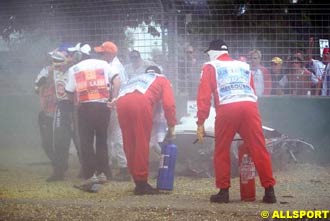I can clearly remember June 20, 2004 at the United States Grand Prix. Ralf Schumacher's rear tyre on his Williams failed, pitching his car into the concrete wall at speeds of up to 180 mph (290 km/h). I remember watching the safety car being deployed and not matter what was said to Michael, every single time he passed his stricken brother, he would nearly stop.
 It was less than one year prior that the HANS (head and neck support) system had become mandatory for all the drivers. Attached to the driver's helmet, the purpose of the device was to stop the head from whipping forward in a crash. I can remember watching the track marshals and stewards cover the view of Ralf from the public with white sheets. My heart sank. Later we learned that Ralf Schumacher suffered primarily a fractured spine. Without the mandate of the HANS device, this crash would have taken a different turn.
It was less than one year prior that the HANS (head and neck support) system had become mandatory for all the drivers. Attached to the driver's helmet, the purpose of the device was to stop the head from whipping forward in a crash. I can remember watching the track marshals and stewards cover the view of Ralf from the public with white sheets. My heart sank. Later we learned that Ralf Schumacher suffered primarily a fractured spine. Without the mandate of the HANS device, this crash would have taken a different turn.  Yet not all injunctions set out by the FIA work 100%. In 1999, The FIA mandated that wheels are attached to the chassis by tethers to stop them from flying off during accidents. With the amount of crashes caused in Formula One by fly away wheels, the new legislature would and did stop a lot of mishaps until the start of the 2001 season in Albert Park.
Yet not all injunctions set out by the FIA work 100%. In 1999, The FIA mandated that wheels are attached to the chassis by tethers to stop them from flying off during accidents. With the amount of crashes caused in Formula One by fly away wheels, the new legislature would and did stop a lot of mishaps until the start of the 2001 season in Albert Park.  Jacques Villeneuve and Ralf Schumacher, fighting it out on lap four when the worst happened. The two drivers crashed, tether broke and one of Villeneuve's tyre went flying and killed a track marshal. So in 2002, a new regulation was set into place by the FIA, The marshals are better protected thanks to stricter safety standards. Graham Beveridge, a 51-year-old volunteer marshal from the small town of Winfield in Qeensland died. After the race, you could see how it affected all. Villeneuve seemed to have taken it the hardest and it was not his fault. You can read the full press release from F1 Atlas here.
Jacques Villeneuve and Ralf Schumacher, fighting it out on lap four when the worst happened. The two drivers crashed, tether broke and one of Villeneuve's tyre went flying and killed a track marshal. So in 2002, a new regulation was set into place by the FIA, The marshals are better protected thanks to stricter safety standards. Graham Beveridge, a 51-year-old volunteer marshal from the small town of Winfield in Qeensland died. After the race, you could see how it affected all. Villeneuve seemed to have taken it the hardest and it was not his fault. You can read the full press release from F1 Atlas here. Some of the other highlights of the History of Safety in Formula One.
1961 - The Grand Prix Drivers Association (GPDA) is formed.
1963 - Driver's are required to wear fireproof suits and unbreakable, full visor helmets.
1971 - Driver's must be able to be removed from an F1's cockpit within five seconds.
1972 - The six-point seat belt becomes mandatory. Fuel tanks contain security foam.
1980 - Compulsory that every circuit has a permanent medical center.
1994 - Following the deaths of Ayrton Senna and Roland Ratzenbeger, the drivers reform the GPDA.
For the full History of Safety in Formula One check out the Formula1.com's Official Website.



I personally don't think you can beat the Hans Device as a safety addition into motorsport. I've seen first hand the impact they can make and they have saved many lives.
ReplyDeleteSan Marino GP in 1994.
ReplyDeleteIt will always make you wish that the HANS was inplemented earlier. We would still see alot of the greats in the paddock on weekends.
To see how the HANS works first hand would be intersting but not something that I would really wish to see.